Across the United States, venomous snakes have long captivated our collective imagination and instilled fear in many outdoor enthusiasts. From the iconic rattlesnake’s warning buzz to the elusive copperhead’s masterful camouflage, these reptiles represent both natural wonder and potential danger. While fatal snake bites are actually quite rare in the United States—with fewer than 10 deaths annually—understanding these powerful predators is essential for anyone who ventures into their habitats. This article explores fascinating and potentially life-saving facts about America’s most dangerous serpents, detailing their behaviors, habitats, venom characteristics, and the proper precautions to take should you encounter one in the wild.
1. The Eastern Diamondback Rattlesnake Packs America’s Deadliest Bite
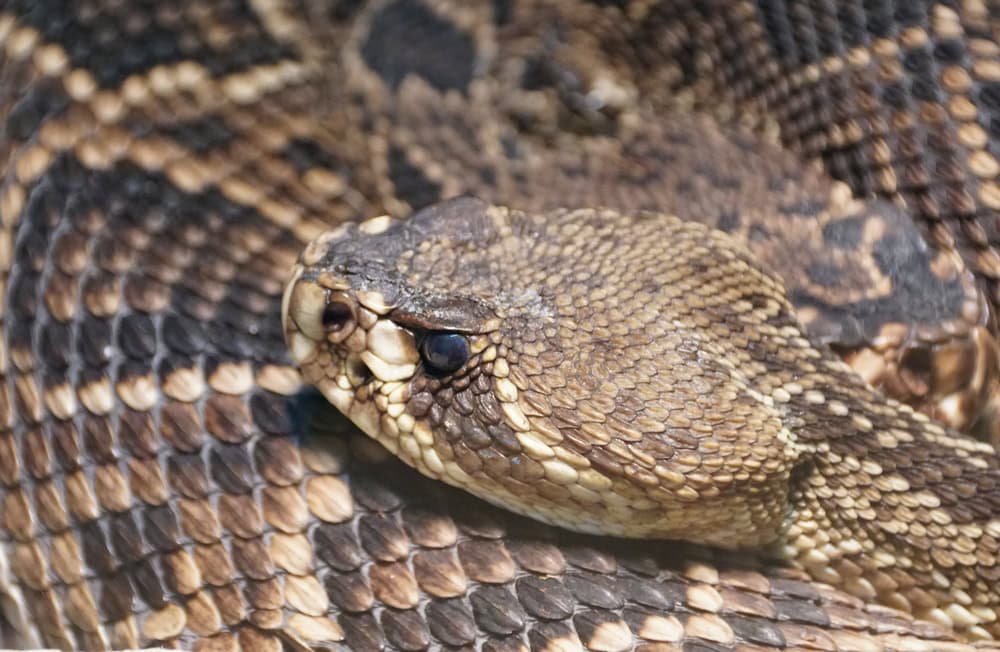
The Eastern Diamondback Rattlesnake (Crotalus adamanteus) holds the notorious distinction of being the most dangerous venomous snake in North America. Growing up to 8 feet long and weighing as much as 10 pounds, this impressive reptile delivers more venom per bite than any other rattlesnake species. Its venom contains powerful hemotoxins that destroy tissue and disrupt blood clotting, potentially leading to severe hemorrhaging, tissue necrosis, and even death if left untreated.
Native to the southeastern United States, particularly Florida, Georgia, and parts of the Carolinas, the Eastern Diamondback prefers pine flatwoods, coastal scrub habitats, and abandoned farmlands. Despite its deadly reputation, this snake is typically not aggressive unless threatened and will usually attempt to warn potential threats with its characteristic rattle before striking.
2. Coral Snakes Have the Most Potent Venom But Rarely Bite Humans

Among North American venomous snakes, the Eastern Coral Snake (Micrurus fulvius) possesses the most potent venom—a powerful neurotoxin similar to that of cobras. Ounce for ounce, coral snake venom is more deadly than that of a rattlesnake. However, human fatalities are exceedingly rare due to the snake’s reclusive nature, reluctance to bite, and inefficient venom delivery system.
Unlike pit vipers with their hinged fangs, coral snakes have short, fixed front fangs that require a chewing motion to inject venom effectively. Identifiable by their distinctive red, yellow, and black bands (remember the rhyme: “Red touch yellow, kill a fellow; red touch black, friend of Jack”), coral snakes are primarily found in the southeastern United States. Their bites may initially seem minor with little pain, but symptoms can progress to slurred speech, double vision, and respiratory paralysis within hours without proper medical intervention.
3. The Mojave Rattlesnake Combines Two Types of Deadly Venom
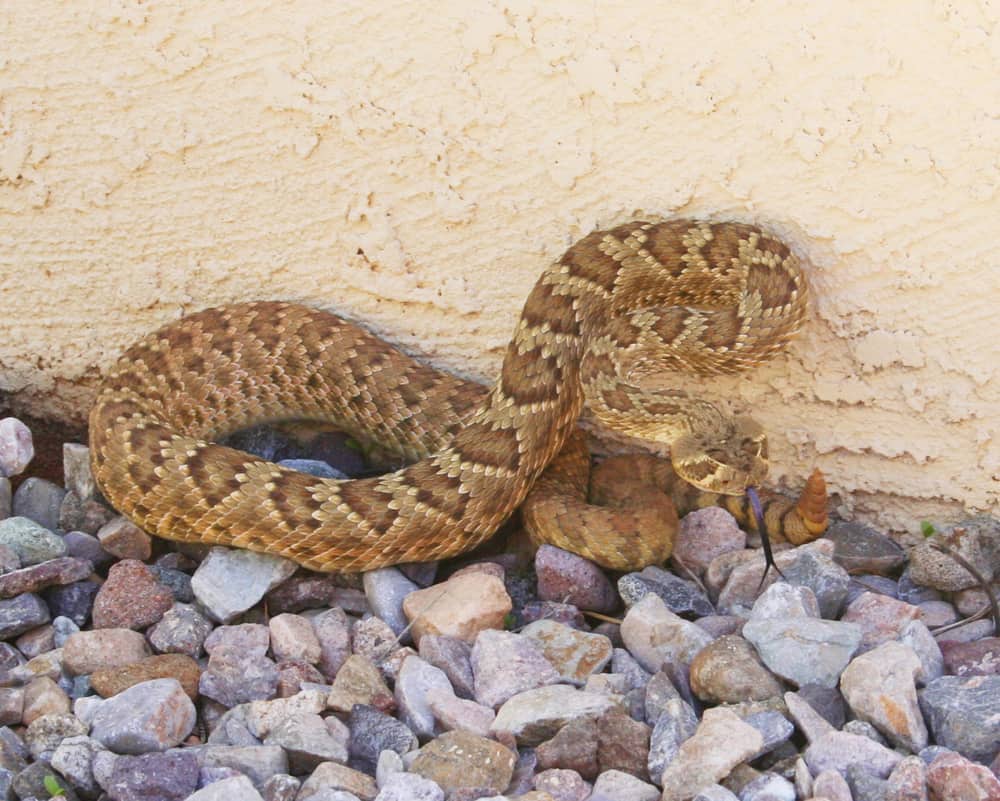
The Mojave Rattlesnake (Crotalus scutulatus) stands out among America’s venomous snakes for its unique venom composition. Unlike most rattlesnakes that primarily produce hemotoxic venom, the Mojave Rattlesnake’s venom contains both hemotoxic components that destroy tissue and neurotoxic elements that attack the nervous system. This dual-action venom makes it particularly dangerous, earning it the nickname “Mojave Green.”
Found throughout the desert Southwest, including parts of California, Arizona, New Mexico, and Texas, this rattlesnake inhabits desert scrub, grasslands, and foothills. What makes this snake especially concerning is that its neurotoxic bite may not cause immediate pain or swelling, leading victims to underestimate the severity of the envenomation. Without prompt medical attention, the neurotoxins can cause respiratory failure within hours, making the Mojave Rattlesnake responsible for more serious envenomations in its range than any other North American snake.
4. Copperheads Are Responsible for the Most Venomous Snake Bites in America
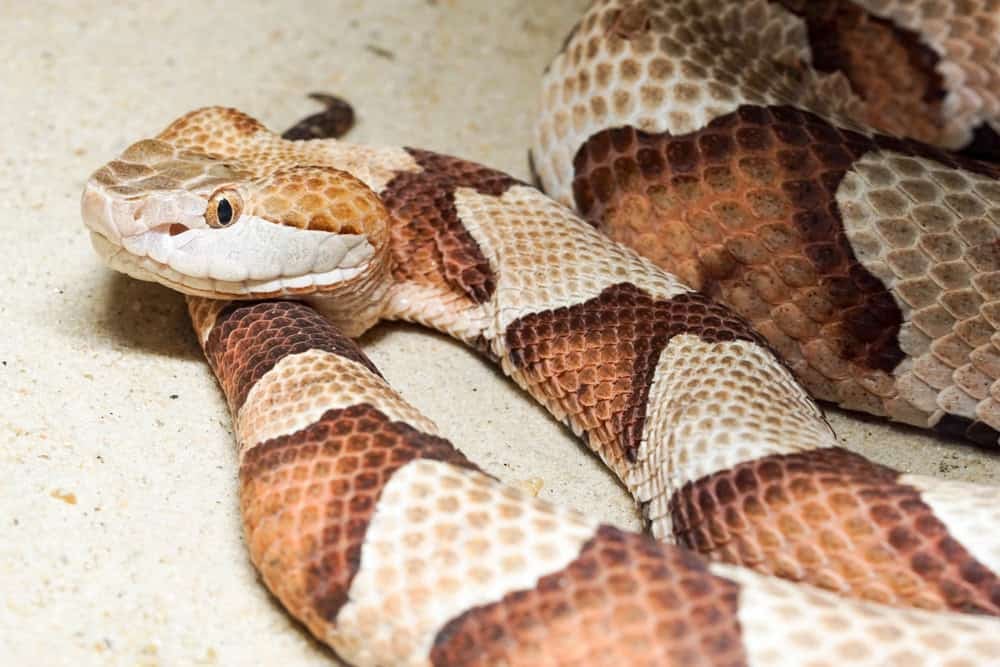
The North American Copperhead (Agkistrodon contortrix) accounts for more venomous snake bites in the United States than any other species—an estimated 2,920 bites annually, representing approximately 30% of all venomous snake bites in the country. This prevalence isn’t due to aggressive behavior but rather to the copperhead’s exceptional camouflage and widespread habitat range throughout the eastern and central United States.
Their copper-colored, hourglass-patterned bodies blend perfectly with forest floors covered in fallen leaves, making them nearly invisible to unsuspecting hikers. Copperheads also tend to freeze rather than flee when threatened, increasing the likelihood of accidental encounters. While their venom is generally less potent than that of rattlesnakes, and fatalities are extremely rare, copperhead bites can cause severe pain, tissue damage, and in some cases, temporary mobility issues. Interestingly, copperheads often deliver “dry bites” with no venom injection, estimated to occur in approximately 25% of bite cases.
5. Timber Rattlesnakes Have Been Documented “Hibernating” with Other Snake Species

The Timber Rattlesnake (Crotalus horridus), one of America’s most iconic venomous snakes, exhibits a fascinating winter survival behavior. During the cold months, these rattlesnakes gather in communal dens called “hibernacula,” often sharing these underground retreats with other snake species, including non-venomous black rat snakes and even other venomous species like copperheads. These dens, typically located in rocky outcroppings with deep crevices that extend below the frost line, can shelter dozens or even hundreds of snakes.
This behavior allows them to survive the harsh winters throughout their range, which spans from New Hampshire to northern Florida and west to Minnesota and Texas. Timber Rattlesnakes show remarkable den fidelity, returning to the same hibernation sites year after year throughout their 30+ year lifespan. Their venom is particularly potent, containing both tissue-destroying hemotoxins and neurotoxins that affect the nervous system, making them among the most medically significant venomous snakes in the eastern United States despite their generally non-aggressive nature.
6. The Water Moccasin Is North America’s Only Venomous Water Snake
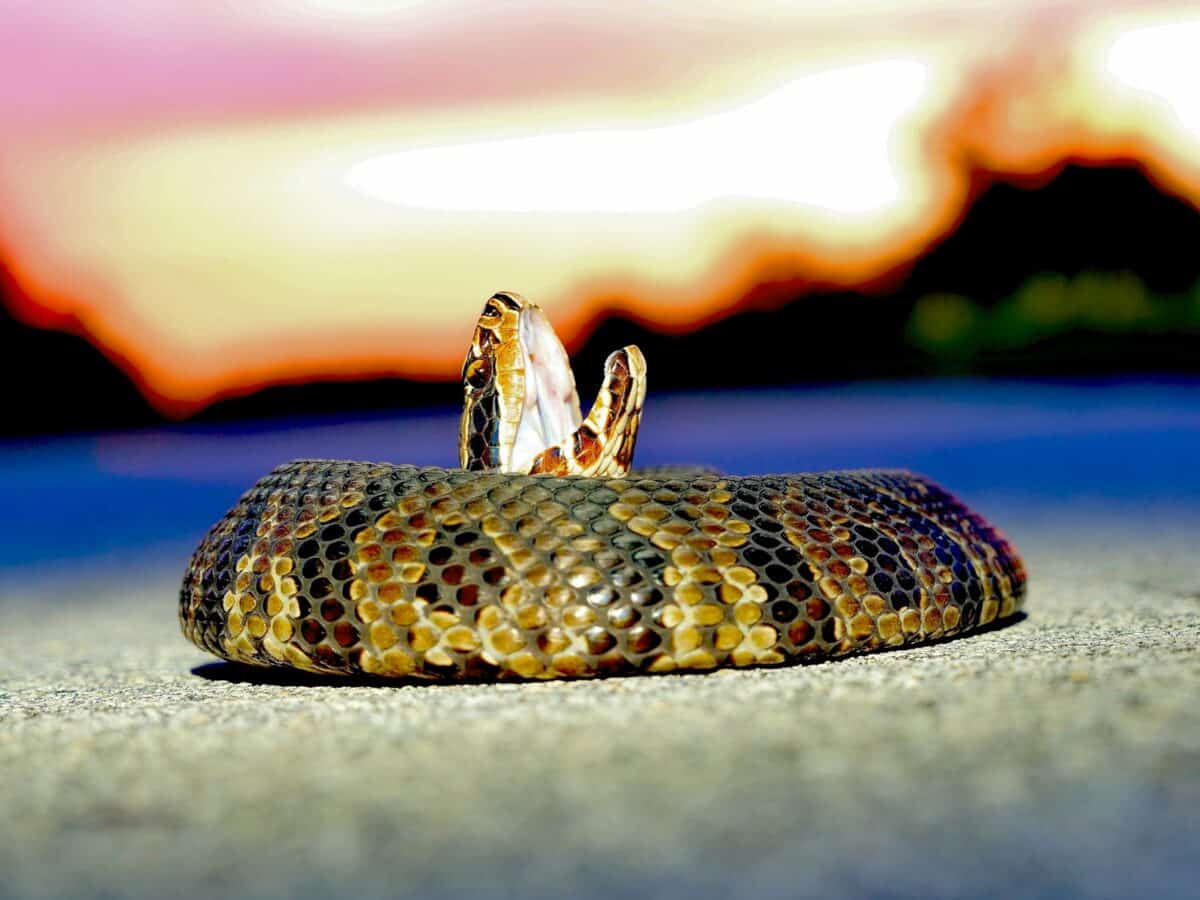
The Water Moccasin or Cottonmouth (Agkistrodon piscivorus) holds the distinction of being the only venomous water snake native to North America. This thick-bodied pit viper inhabits swamps, marshes, drainage ditches, and slow-moving streams throughout the southeastern United States, from Virginia to Florida and west to eastern Texas. Unlike the many non-venomous water snakes with which they’re often confused, cottonmouths possess heat-sensing pits between their eyes and nostrils, vertically elliptical pupils, and the namesake white mouth lining they display when threatened.
These semi-aquatic predators are excellent swimmers, capable of hunting both in water and on land, preying on fish, amphibians, small mammals, birds, and even other snakes. Their venom is primarily hemotoxic, causing tissue damage and preventing blood from clotting properly. While not typically aggressive unless cornered, cottonmouths have a reputation for standing their ground rather than fleeing when confronted—a behavior that distinguishes them from non-venomous water snakes and contributes to their fearsome reputation among outdoor enthusiasts.
7. Antivenom Development Revolutionized Snake Bite Treatment

The development of effective antivenoms has dramatically reduced snake bite fatalities in the United States over the past century. The most widely used product today, CroFab (Crotalidae Polyvalent Immune Fab), was approved by the FDA in 2000 and is effective against all pit viper venoms in North America, including rattlesnakes, cottonmouths, and copperheads. This antivenom is produced by injecting sheep with small amounts of venom from four different snake species, then harvesting the antibodies they produce.
For coral snake bites, a separate antivenom exists, though its production was temporarily discontinued in 2010, creating significant concerns about treatment availability until production resumed. Before modern antivenom development, snake bite mortality rates in the U.S. exceeded 25% for severe envenomations; today, that figure has dropped to less than 0.25%. However, antivenom remains extremely expensive, with treatment costs potentially reaching $150,000 for severe cases requiring multiple vials. Access to these life-saving medications can also be challenging in rural areas, where many snake bites occur, as some smaller hospitals may not stock antivenom due to its high cost and limited shelf life.
8. The Western Diamondback Rattlesnake Has Remarkable Heat-Sensing Abilities
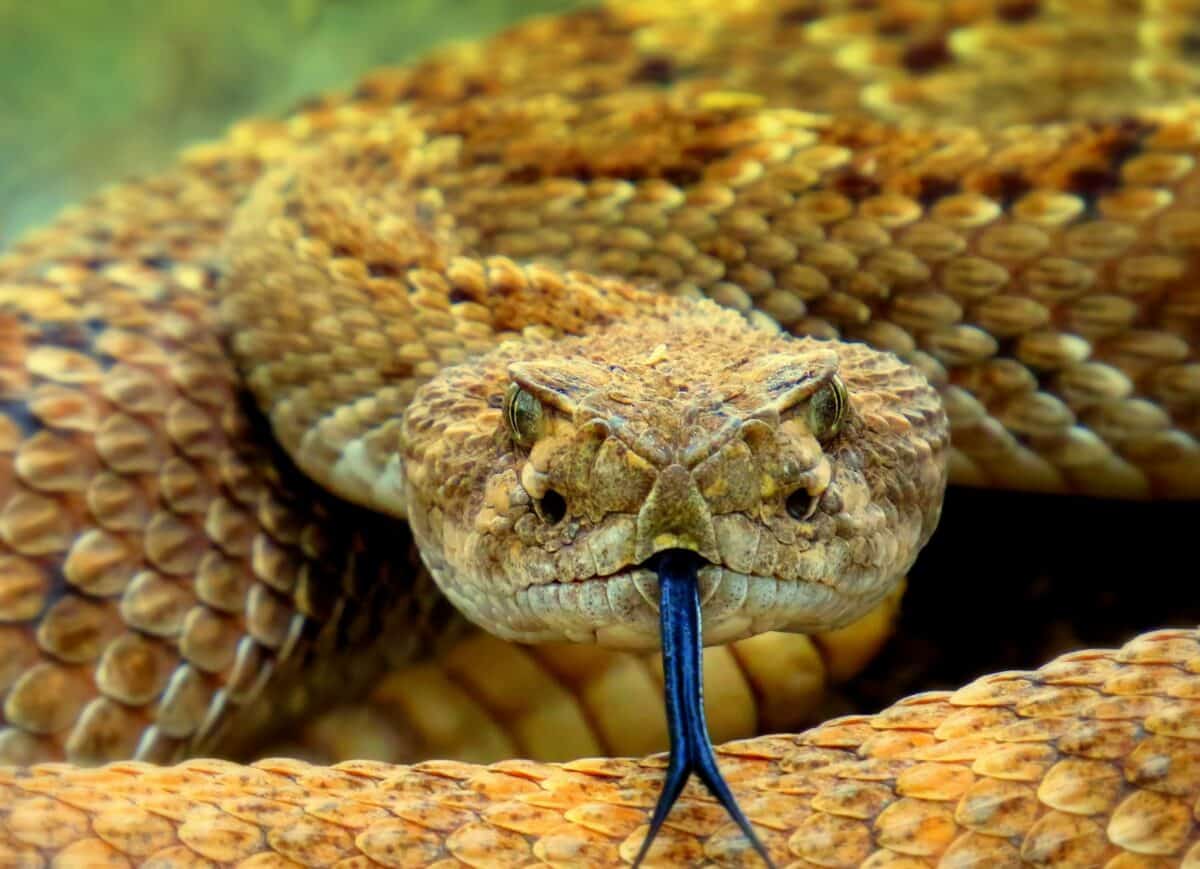
The Western Diamondback Rattlesnake (Crotalus atrox), a formidable predator of the American Southwest, possesses extraordinarily sensitive heat-detection capabilities through specialized organs called pit organs. Located between the eye and nostril on each side of the head, these organs can detect temperature differences as small as 0.003°C and allow the snake to create a thermal image of its surroundings. This remarkable adaptation enables Western Diamondbacks to locate warm-blooded prey with precision even in complete darkness or when the prey is motionless.
Research has shown that these pit organs are so sensitive they can detect the body heat of a small mammal from over one foot away. This heat-sensing ability, combined with their potent hemotoxic venom and impressive size—regularly reaching 4-6 feet in length—makes the Western Diamondback one of America’s most efficient predators. Found throughout the southwestern United States and northern Mexico, these rattlesnakes are responsible for more snake bite fatalities in Mexico and the second-highest number in the United States, behind only their eastern cousins.
9. Pygmy Rattlesnakes Deliver a Surprising Punch Despite Their Small Size
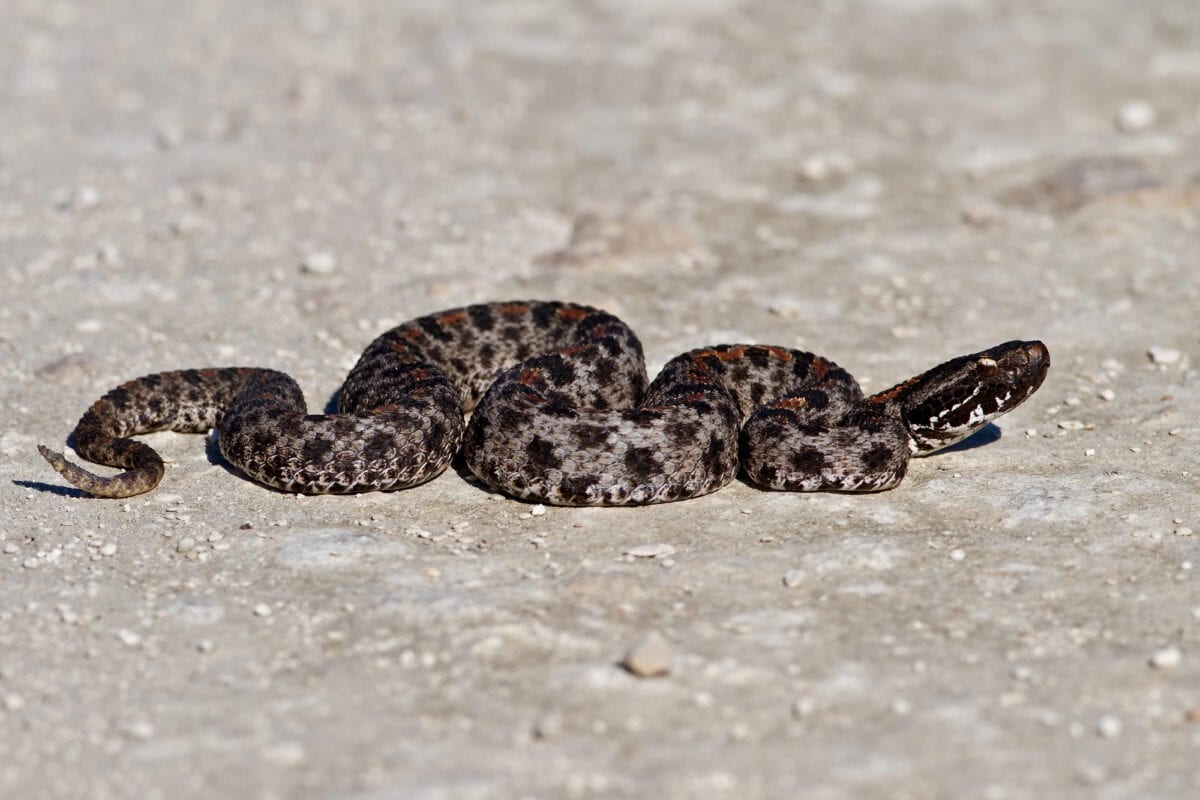
The Pygmy Rattlesnake (Sistrurus miliarius), also known as the ground rattler, proves that deadly potential comes in small packages. Rarely exceeding 30 inches in length, this diminutive pit viper inhabits the southeastern United States from eastern North Carolina to eastern Texas and throughout Florida. Despite their small size, Pygmy Rattlesnakes possess a surprisingly potent venom that contains powerful cytotoxic components causing tissue damage and, in some cases, prolonged bleeding.
Their rattles are so small they produce more of a buzzing sound than the characteristic rattle of their larger cousins—often difficult for humans to hear, increasing the risk of accidental encounters. These snakes frequently hunt during daylight hours, unlike many other venomous species, and feed primarily on frogs, lizards, insects, and small rodents. Due to their small size and excellent camouflage, Pygmy Rattlesnakes are often stepped on by unsuspecting hikers, resulting in defensive bites. While rarely fatal to adults, their bites can cause significant local tissue damage, extreme pain, and can be particularly dangerous for children or pets due to their smaller body mass.
10. The Prairie Rattlesnake Has Evolved Different Venom Compositions Across Its Range

The Prairie Rattlesnake (Crotalus viridis) exhibits a fascinating evolutionary adaptation: its venom composition varies significantly depending on its geographic location. Found across the Great Plains from Canada to Mexico, these snakes have developed region-specific venom profiles optimized for local prey species. In northern populations, the venom contains higher concentrations of neurotoxins effective against small mammals like prairie dogs, while southern populations produce venom with stronger hemotoxic properties suited to different prey assemblages.
This venom variability presents unique challenges for medical treatment, as the symptoms and progression of envenomation can differ based on the snake’s origin. Prairie Rattlesnakes are particularly important in their ecosystems, controlling rodent populations across vast agricultural regions. They can be identified by their brownish coloration with dark oval blotches and a yellowish stripe running from each eye to the corner of the mouth. Like other rattlesnakes, they give birth to live young rather than laying eggs, with average litters of 4-12 offspring that are fully venomous from birth, capable of delivering potentially dangerous bites despite their small size.
11. Sidewinders Have Evolved a Unique Locomotion Method for Desert Survival

The Sidewinder Rattlesnake (Crotalus cerastes) has evolved one of the most specialized and efficient methods of locomotion in the snake world to navigate its challenging desert habitat. Rather than moving in a traditional serpentine pattern, sidewinders move laterally by throwing their bodies in J-shaped loops, with only two points of their bodies touching the sand at any given time. This distinctive sideways movement, which can reach speeds up to 18 miles per hour in short bursts, minimizes contact with scorching hot sand and prevents the snake from sinking into loose substrates.
Native to the deserts of the southwestern United States and northwestern Mexico, sidewinders are instantly recognizable by their horn-like supraocular scales above each eye, which may help shield their eyes from sand and sun. Though smaller than many other rattlesnakes, typically reaching only 1.5-2.5 feet in length, sidewinders possess potent hemotoxic venom that can cause tissue damage and bleeding disorders. Their remarkable adaptations to extreme desert environments, including their ability to survive in temperatures exceeding 120°F, make them one of North America’s most specialized venomous snakes.
12. Snake Bite First Aid Has Evolved Dramatically Over Time

The recommended first aid approach for venomous snake bites has undergone radical transformation over the decades, with many once-common practices now recognized as harmful. Historical methods such as cut-and-suck techniques, tourniquets, ice application, and electrical shock treatments have been abandoned by medical professionals as research has shown they often worsen outcomes. Current medical consensus emphasizes a “less is more” approach that focuses on immobilization and rapid transport to medical care. The modern snake bite protocol advises victims to remain calm to slow venom circulation, remove constricting items like jewelry or tight clothing, keep the bitten extremity immobilized at or below heart level, and seek immediate medical attention.
The widespread adoption of pressure immobilization bandages for elapid (coral snake) bites but not for pit viper bites reflects our growing understanding of how different venoms move through tissue. The single most important factor in snake bite survival remains the speed with which antivenom can be administered, with outcomes dramatically improving when treatment begins within the first four hours after envenomation. This evolution in treatment protocols has contributed significantly to the decline in snake bite mortality rates in the United States, despite thousands of bites occurring annually.
Understanding America’s Venomous Serpents: Respect, Not Fear

America’s venomous snakes represent a fascinating intersection of evolutionary adaptation, ecological importance, and potential medical significance. Despite their fearsome reputations, these remarkable reptiles play crucial roles in their ecosystems as both predators and prey, helping to control rodent populations and serving as food for numerous wildlife species.
Their venom—a complex cocktail of proteins evolved over millions of years—continues to yield new medical discoveries, with compounds derived from snake venoms now used in medications for conditions ranging from hypertension to chronic pain. The development of effective antivenoms has transformed snake bites from frequently fatal events to largely survivable medical emergencies when promptly treated. By cultivating respect rather than fear for these important animals, practicing appropriate caution in snake country, and preserving their habitats, we can continue to coexist with America’s venomous snakes while appreciating their remarkable adaptations and contributions to our natural heritage.
- This Lizard Shoots Blood From Its Eyes - August 17, 2025
- 12 Facts About America’s Deadliest Snakes - August 17, 2025
- This Ocean Creature Moves the Slowest—but Lives the Longest - August 17, 2025

